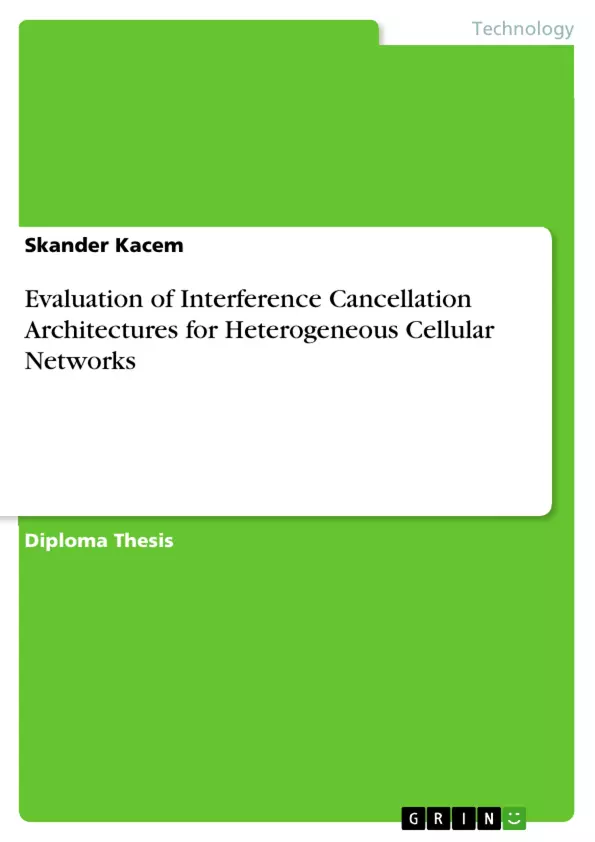With the increasing data throughput requirements, the cellular network needs to move from homogeneous to heterogeneous system. In fact, the coexistence of different types of base stations with different capabilities such as femto/pico base stations as well as relays and macro base stations in random placements should improve the coverage and the spectral efficiency of the cellular networks.
However, the complexity of inter-cell interference management will grow drastically and traditional interference avoidance/mitigation approaches need to be revised.
Approaching this problem at the user equipment (UE), is of great interest since it can rely on little coordination among base stations.
The work presented in this thesis focuses on a downlink interference cancellation at the UE and shows that such an intelligent receiver can bring its promised benefit only if the base stations get involved in the interference cancellation, specifically in the channel estimation process. The limitations of this approach are evaluated and depending on the surrounding base stations two solutions are proposed and discussed.
Inhaltsverzeichnis (Table of Contents)
- Notations
- Acronyms
- 1 Introduction
- 1.1 Motivation and Objective
- 1.2 Outline and Organization of the Thesis
- 2 Fundamentals
- 2.1 Bit-Interleaved Coded Modulation
- 2.1.1 System and Signal Model
- 2.1.2 Low Complexity LLR Metrics for BICM Receivers
- 2.2 Interference-Aware System
- 2.2.1 IA Receiver: System & Signal Model
- 2.1 Bit-Interleaved Coded Modulation
- 3.1 System Parameters & General Code Structure
- 3.2 Radio Propagation Channel
- 3.2.1 Simulation of AWGN-Channel model
- 3.2.2 Path Loss Channel Model
- 3.2.3 Simulation of Rayleigh Fading Channel
- 3.3 The Baseband Part of the Transmitter
- 3.3.1 Convolutional Coding and Puncturing
- 3.3.2 Bit-Interleaver
- 3.3.3 Bit-Level Scrambling
- 3.4 Interference Model
- 3.5 The Baseband Part of the Receiver
- 3.5.1 Pilot-based Channel Estimation
- 3.5.2 De-Puncturing and Soft Output Viterbi Decoding
- 3.5.3 Metric Computing Device
- 3.6 Base Stations Channel Estimation Enhancement
- 3.6.1 Serving Base Station: Holes
Zielsetzung und Themenschwerpunkte (Objectives and Key Themes)
This thesis aims to evaluate the effectiveness of interference cancellation architectures for heterogeneous cellular networks. It explores the challenges of managing inter-cell interference in such networks and investigates the potential benefits of downlink interference cancellation at the user equipment (UE).
- Interference cancellation in heterogeneous cellular networks
- Downlink interference cancellation at the user equipment (UE)
- The role of base stations in interference cancellation
- Limitations and solutions for interference cancellation
- Evaluation of different interference cancellation architectures
Zusammenfassung der Kapitel (Chapter Summaries)
The thesis begins with an introduction that outlines the motivation and objectives of the work. Chapter 2 provides foundational information on bit-interleaved coded modulation (BICM) and interference-aware systems. It describes the system and signal models for these concepts, including the low-complexity LLR metrics for BICM receivers. The third chapter focuses on the structure of the simulator used for the analysis. It details the system parameters, code structure, radio propagation channel modeling, and the baseband parts of the transmitter and receiver. The chapter also includes information on interference modeling and channel estimation techniques. Chapter 4 examines the limitations of downlink interference cancellation and proposes two potential solutions depending on the surrounding base stations.
Schlüsselwörter (Keywords)
Heterogeneous cellular networks, interference cancellation, downlink, user equipment, channel estimation, base stations, BICM, LLR metrics, simulation, radio propagation channel, interference modeling, AWGN-channel, Rayleigh Fading Channel, path loss, convolutional coding, puncturing, de-puncturing, Soft Output Viterbi Decoding, pilot-based channel estimation.
- Arbeit zitieren
- Skander Kacem (Autor:in), 2012, Evaluation of Interference Cancellation Architectures for Heterogeneous Cellular Networks, München, GRIN Verlag, https://www.hausarbeiten.de/document/229965


